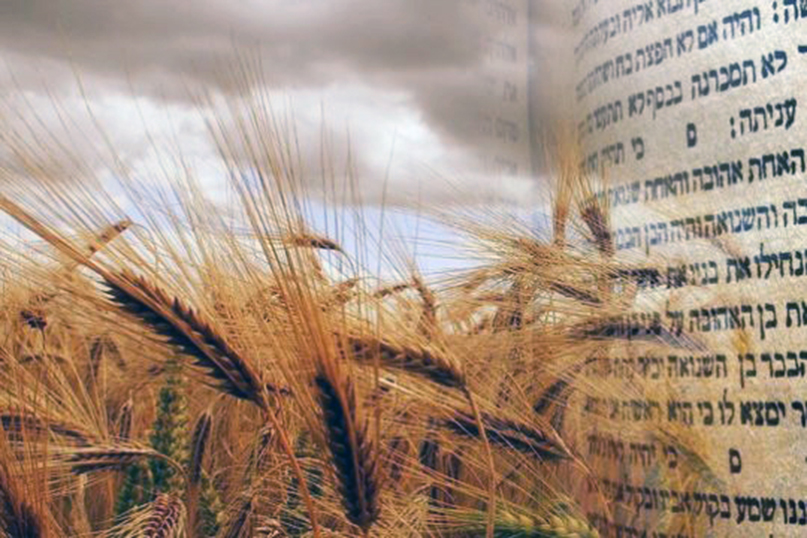
The holiday marked seven weeks after Passover, highlights the concept of spiritual liberty.
By Yoram Ettinger
(JNS) Shavuot, which is marked this year from the evening of June 4 (after Shabbat) through the evening of June 6 (one day less in Israel), is one of the three liberty-oriented Jewish pilgrimages to Jerusalem: Pessach (Passover), Shavuot (Pentecost) and Sukkot (Tabernacles).
Shavuot is celebrated seven weeks after the second day of Passover, of which it is a historical, national, agricultural and spiritual extension. Passover highlights the physical liberty from slavery in Egypt; Shavuot highlights the spiritual liberty, embracing the values of the Ten Commandments and the Torah, in preparation for re-entry into the Land of Israel.
Shavuot is also called the Holiday of the Harvest (ביכורים) since it concludes the harvest season, which starts during Passover.
Shavuot (שבועות) means “weeks” in Hebrew; its spelling is identical to the Hebrew word for “vows.”
Shavuot commemorates the 40 years of the Exodus, which entailed tough challenges on the way to the Land of Israel, forging the state of mind of the Jewish people and the Jewish State. For example:
• Earning and sustaining liberty – which is a most critical value – requires the willingness to endure tribulations (blood, sweat and tears);
• Walking against the grain and a can-do mentality – no challenge is insurmountable when met by faith and principle-driven determination;
• The steeper the hurdle, the more critical the mission, the deeper the gratification;
• Adversities and challenges are opportunities in disguise.
The book of Ruth (Honor thy mother-in-law)
Shavuot spotlights the Book of Ruth, the first of the five biblical megillot (scrolls) studied during five Jewish holidays: Ruth (Shavuot), Song of Songs (Passover), Ecclesiastes (Sukkot), Lamentations (Tisha B’av) and Esther (Purim).
Ruth was a Moabite princess, the great-grandmother of King David.
Ruth was a role model of loyalty to her Jewish mother-in-law (“Your people are my people and your God is my God”), humility, gratitude, responsibility, reliability, respect for fellow human beings, faith and optimism. According to the Bible, Ruth, the daughter-in-law, was better than seven sons. Ruth stuck by her mother-in-law, Naomi, during Naomi’s roughest time, when the latter lost her husband, Elimelech (a president of the tribe of Judah), two sons and property.

Just like Job, Naomi bounced back from the lowest ebb of her ordeal to fulfilled hope. Job and Naomi both went through family, economic and social calamities, lost their spouses, children and financial assets; both retained confidence in God and reconstructed their families; both became symbols of conviction over convenience, faith-driven patience and endurance.
The legacy of Ruth reflects the central role played by biblical women, joining the matriarchs Sarah, Rebecca, Leah and Rachel; Miriam, the older sister of Moses; Deborah the Prophetess, judge and military leader; Hannah, the mother of Samuel the Prophet; Queen Esther, etc.
The geographic setting of the Book of Ruth was the Judean Desert, the cradle of Jewish history, religion, culture, language and ethnicity.
Impact on the formation of the United States
Shavuot commemorates the legacy of Moses: the Exodus, the Ten Commandments and the Torah, which had a significant impact on the Early Pilgrims and the Founding Fathers, and the formation of the U.S. culture, civic life, the federal system, the American Revolution (as highlighted by Thomas Paine’s Common Sense), the Federalist Papers, the U.S. Constitution, the Bill of Rights, etc.
The U.S. Liberty Bell
Shavuot is the holiday of liberty/Exodus, as highlighted by the biblical concept of Jubilee, the role model of biblical liberty, which is celebrated every 50 years. The essence of the Jubilee is inscribed on the Liberty Bell: “Proclaim liberty throughout all the land and unto all the inhabitants thereof” (Leviticus 25:10).
The Liberty Bell was installed in Philadelphia in 1752, 50 years following William Penn’s Charter of Privileges, and eventually inspiring the 50 states in the union. According to the biblical Jubilee, all slaves must be released and land must be returned to the original proprietors every 50 years. Shavuot is celebrated 50 days following Passover, and Pentecost – a derivative of the Greek word for 50 – is celebrated 50 days following Easter. According to Judaism, there are 50 gates of wisdom, studied during the 50 days between Passover and Shavuot.
The centrality of humility
Shavuot highlights the critical value of humility in human behavior and leadership. This is underlined by the receipt of the Torah, the Ten Commandments and the 613 statutes in the desert – an uncomfortable environment – and on Mount Sinai, which is not an overpowering mountain. Moses, the exceptional law-giver and civic and military leader, was accorded only one compliment in the entire Bible: “the humblest of all human beings.”
‘The Ethics of the Fathers’ (Pirkei Avot)
It is customary to study – from Passover through Shavuot – the six brief chapters of The Ethics of the Fathers, one of the 63 tractates of the Mishnah (the Oral Torah) – a compilation of common-sense principles and ethical and moral teachings which underline key interpersonal relationships. For example:
“Who is respected? He who respects other persons!”
“Who is a wise person? He who learns from all other persons!”
“Who is wealthy? He who is satisfied with his own share!”
“Who is a hero? He who controls his urge!”
“Talk sparsely and walk plenty;”
“If I am not for myself, who will be for me? If I am only for myself, what am I? If not now, when?”
“Don’t be consumed with the flask, but with its content.”
“Conditional love is tenuous; unconditional love is eternal.”
“Treat every person politely.”
“Jealousy, lust and the obsession with fame warp one’s mind.”
Shavuot and the significance of seven
Shavuot reflects the centrality of the number seven in Judaism. The Hebrew root of the word Shavuot (שבועות) is seven (שבע – sheva), which is also the root of “vow” (שבועה – shvua), “satiety” (שובע – Sova) and “week” (שבוע – shavua).
Shavuot is celebrated seven weeks after Passover. Shabbat was the seventh day of the Creation, and according to Genesis, has seven beneficiaries.
The first Hebrew verse of Genesis consists of seven words. God created seven universes – the seventh universe hosts the pure souls (hence the phrase “Seventh Heaven”). There were seven monumental Jewish leaders – Abraham, Isaac, Jacob, Moses, Aaron, Joseph and David, representing seven key human qualities. There were seven Jewish prophetesses – Sarah, Miriam, Devorah, Hana, Abigail, Hulda and Esther.
There are seven major Jewish holidays – Rosh Hashanah, Yom Kippur, Tabernacles, Hanukkah, Purim, Passover and Shavuot. There was a seven-day-recess between each of the Ten Plagues of Egypt. The ancient Jewish Temple had a seven-branched menorah. There are the biblical “seven species” – barley, wheat, grape, fig, pomegranate, olive and date/honey. The Jubilee follows a seven seven-year-cycle.
Yoram Ettinger is a former ambassador and head of Second Thought: A U.S.-Israel Initiative.
This article was first published by The Ettinger Report.
On Shavuot we received the Torah…the medium of revelation
By Shmuel Reichman
We experience life through the medium of time. Each new moment brings with it new opportunities as we ascend through the journey of time. Amidst the constantly moving waves of time, the chagim (Jewish holidays) are specific points imbued with unique energy. Each holiday presents us with the opportunity to tap into and experience the theme inherent at that point in time.
If Shavuot is the time of kabbalat ha’Torah (receiving of the Torah), to truly understand what we are trying to experience on Shavuot, we must first understand what Torah is. To truly understand the importance of the receiving of the Torah, we must understand the Torah’s true depth.
What is Torah?
Torah is not simply a guide to living a life of truth within this world; it is the blueprint and DNA of the world itself. In other words, our physical world is a projection and emanation of the deep spiritual reality described in the Torah. This is the meaning behind the famous Midrash, “ Istakel b’Oraisah u’barah almah,” Hashem looked into the Torah and used it to create the world (Bereishis Rabbah 1:1). Torah is the spiritual root of existence, the physical world is its expression. To illustrate this concept, imagine a projector. The image that you see on the screen emanates from the film in the projector, so that everything you see on the screen is simply an expression of what’s contained within the film. So too, every single thing that we see and experience in the physical world stems from the spiritual root – the transcendent dimension of Torah.
Thus, the world in which we live is an avenue to the spiritual – we can access the spiritual, transcendent world through the physical world because the two are intimately, intrinsically connected.

Think of the way in which others experience and understand you. All they can see of you is your physical body. They cannot see your thoughts, your consciousness, your emotions, your soul. All they can see are your actions, words, facial expression, and body language- the ways in which you express yourself within the world. They cannot see your inner world, but they can access it through the outer expressions that you project. The same is true of those trying to experience Hashem and the spiritual. We cannot see the spiritual, we cannot see what is ethereal and transcendent, only that which is physical. However, we can use the physical to access the spiritual root; we can study the Torah’s expression in this world to understand its spiritual root.
The World is a Mashal
The more fully grasp the depth of this concept, we must understand the nature and purpose of a mashal. A mashal is an analogy, an example one gives in order to explain something abstract and conceptual to one who does not yet understand it. If a teacher wants to share a deep principle with his or her students, they might share a story or analogy that depicts the idea through a more relatable medium. While the mashal does not fully convey the idea itself, it leads the listener towards it, aiding him or her in the process of understanding. Deep ideas cannot be taught, as they are beyond words. The job of the teacher is to guide the student towards the idea, until the idea falls into the student’s mind with clear understanding. A mashal serves as a guiding force in this process.
This process itself can be understood through a mashal. You cannot teach someone how to ride a bike. You can only help them, holding on while they practice, and perhaps showing them an example of how it is done. Ultimately though, you must let go, and the student will have to learn how to ride it independently. Once you learn how to ride a bike, it’s hard to imagine not being able to ride one. Yet, despite the fact that we know how to ride a bike, we will not be able to explain how to ride a bike to someone else. It is simply beyond words.
A mashal is the only tool a teacher can use to teach spiritual truths; the learning and understanding must be done within the inner mind of the student. But we cannot see, touch, or feel the spiritual world, so how are we to relate to it? If all learning occurs through the use of analogy, what mashal did Hashem give us to enable us to relate to and understand spiritual truths?
The ultimate mashal is the world itself. It is here to guide us towards a deeper, spiritual truth. Everything in this world is a mashal, a tool guiding us towards a deeper reality. Every physical object, every emotional phenomenon, every experience in this world is part of a larger mashal leading us towards the root of all existence, Hashem.
Our Shavuot Mission
Our mission is to make this Shavuot the next step in our evolutionary spiral through time. We must not only re-accept what we have already accepted, we must take it to the next level, the next rung of the ladder. We do not simply remember, we build; we do not repeat, we ascend. May we be inspired to accept the Torah this Shavuot with all of our heart, to commit to living a life of Torah truth, and to endlessly pursue higher and deeper perceptions of the physical world as an expression of a spiritual reality.
Rabbi Shmuel Reichman, MA, MS, is CEO of Self-Mastery Academy. He is currently pursuing a PhD at the University of Chicago. Visit his website at shsmuelreichmen.com.








 Southern New England Jewish Ledger
Southern New England Jewish Ledger









